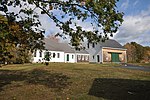Spurwink River
Maine river stubsRivers of Maine

The Spurwink River is a 4.6-mile-long (7.4 km) primarily tidal river in Cumberland County, Maine. It rises in the town of Cape Elizabeth and flows west, then southwest, through salt marshes to its mouth at the Atlantic Ocean. It is bridged by Maine State Route 77 at the river's approximate halfway point. From a point shortly above the bridge to the river's mouth, it forms the boundary between Cape Elizabeth to the east and the town of Scarborough to the west. The river's mouth is at the Scarborough village of Higgins Beach.
Excerpt from the Wikipedia article Spurwink River (License: CC BY-SA 3.0, Authors, Images).Spurwink River
Winters Lane,
Geographical coordinates (GPS) Address Nearby Places Show on map
Geographical coordinates (GPS)
| Latitude | Longitude |
|---|---|
| N 43.55786 ° | E -70.27255 ° |
Address
Winters Lane 10
04107
Maine, United States
Open on Google Maps









